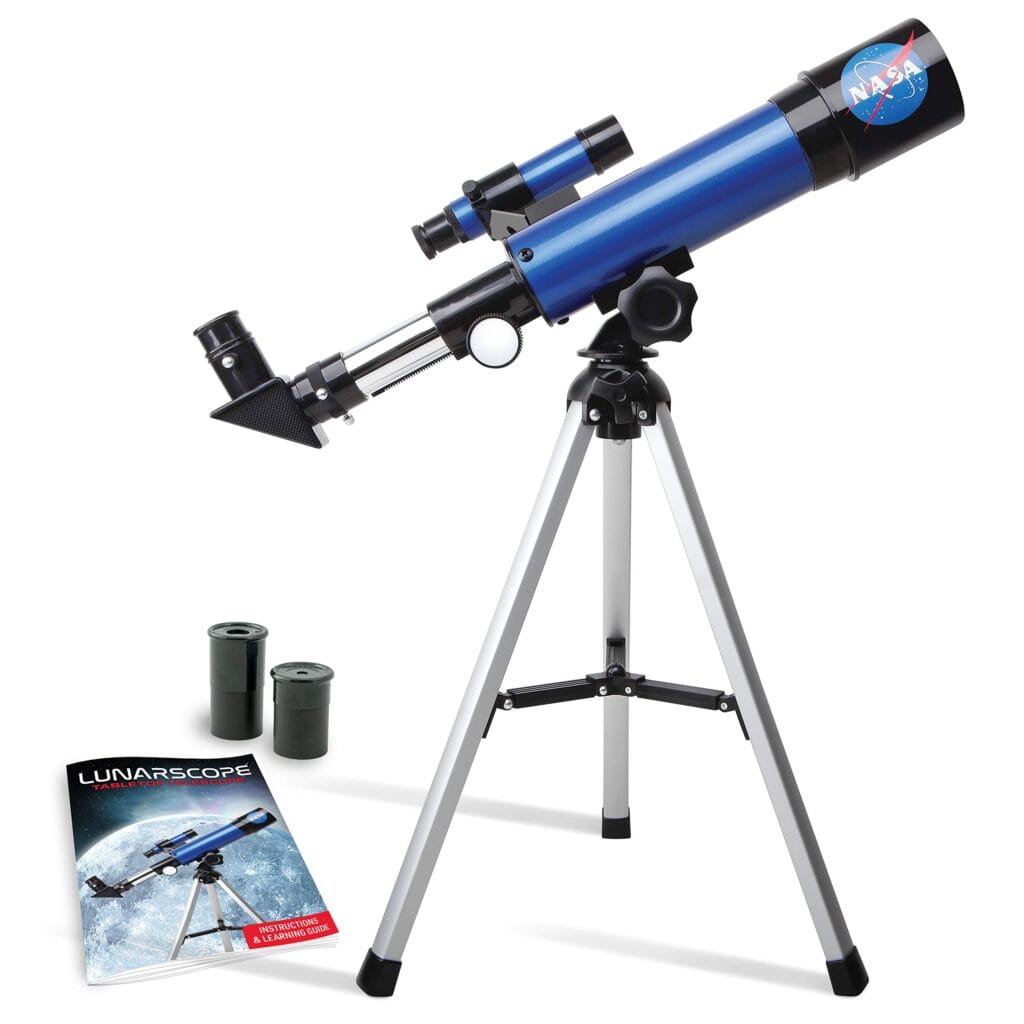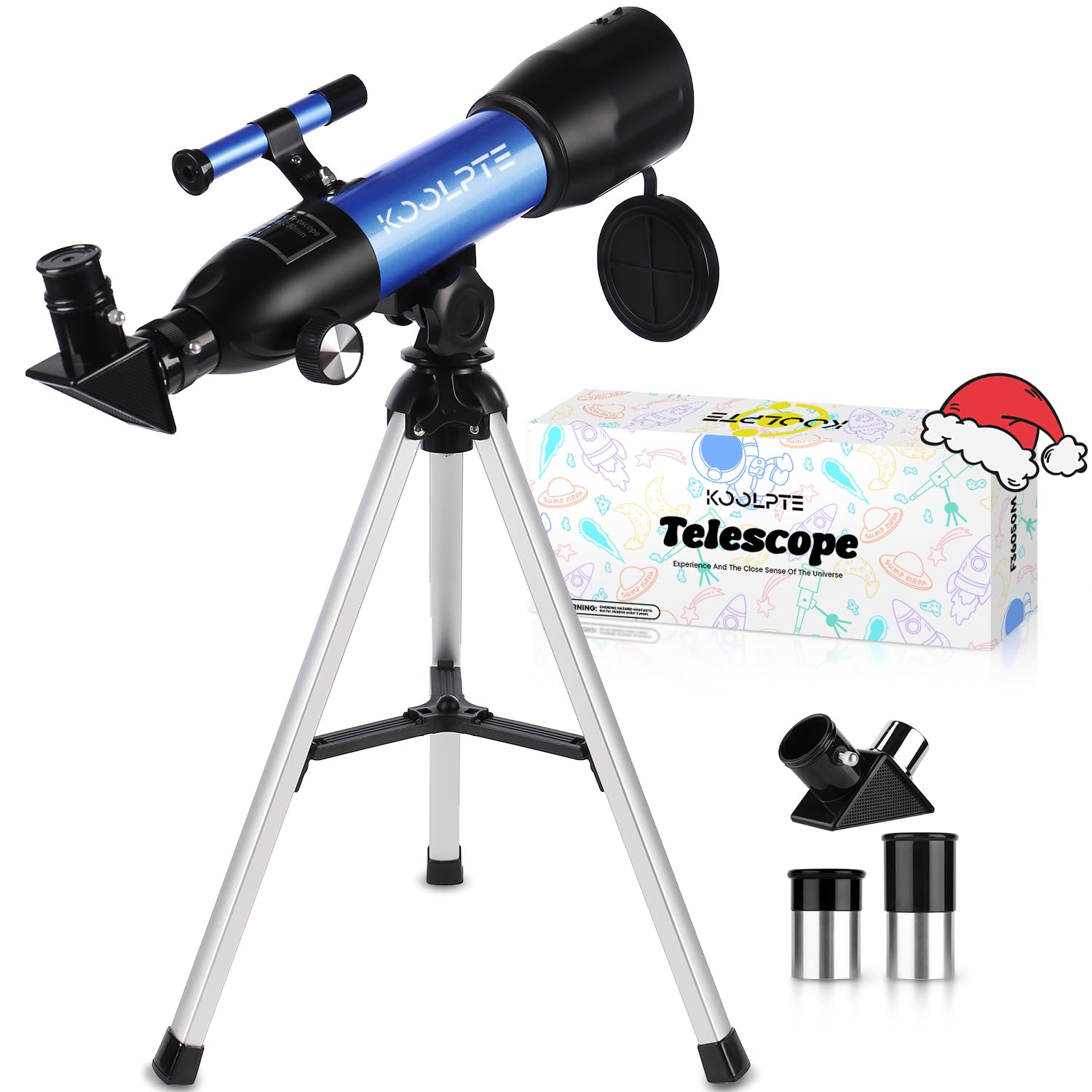
Telescopes open up a world of wonder for kids. They allow kids to explore the night sky and learn about celestial objects. These optical instruments magnify distant planets, stars, and galaxies, bringing them into clear view. A good telescope for children can spark curiosity about space and science. It can also encourage their interest in astronomy from an early age.
Choosing the right telescope for kids is important. It should be easy to use, durable, and provide clear images. A telescope that’s too complex or difficult to set up may discourage young stargazers. On the other hand, a well-designed telescope can make astronomy fun and exciting for children.
When picking a telescope for kids, we need to look at factors like magnification power, aperture size, and stability. The telescope’s weight and portability also matter, especially for younger children.
We want a telescope that’s sturdy enough to withstand handling by kids but light enough for them to move around.
We tested several telescopes designed for children to find the best options for young astronomers.
Best Telescopes for Kids
We’ve put together a list of top telescopes perfect for young stargazers. These kid-friendly models are easy to use and offer clear views of the night sky. They’ll spark curiosity about space and astronomy in children of all ages.
Gskyer 70mm Telescope
We think this telescope is a good choice for kids and beginners who want to start stargazing without breaking the bank.
Pros
- Easy to set up and use
- Includes smartphone adapter
- Portable with carry bag
Cons
- Limited magnification power
- Can be shaky on windy nights
- Plastic parts feel cheap
We tried out the Gskyer 70mm telescope and found it to be a solid starter scope for kids. The 400mm focal length let us see the moon’s craters and Jupiter’s moons.
Setting it up was quick, taking only about 10 minutes to assemble.
The smartphone adapter is a nice touch. We snapped some decent moon photos using it. The carry bag made it easy to take on camping trips.
At just 5.7 pounds, it’s light enough for older kids to carry themselves.
We did notice some downsides. On windy nights, the image would shake a bit. The plastic parts don’t feel very durable. For viewing distant galaxies or nebulae, you’ll want a more powerful scope. But for learning the basics of astronomy, this Gskyer model fits the bill.
Koolpte Kids Refractor Telescope
This beginner-friendly telescope is a great choice for young stargazers looking to explore the night sky.
Pros
- Easy setup and use
- Portable design
- Clear optics for its size
Cons
- Limited magnification
- Plastic components
- Basic tripod
We found the Koolpte Kids Refractor Telescope to be a solid starter scope for budding astronomers. Its 50mm aperture and 360mm focal length provide nice views of the Moon, planets, and bright stars.
The optics are good for the price, giving clear images without much distortion.
The telescope comes with two eyepieces, which let kids switch between different magnifications.
We liked how light and portable it is – perfect for taking on camping trips or to dark sky sites. The setup is quick and easy, so kids can start observing within minutes.
While it won’t show deep sky objects like larger scopes can, we think it’s just right for getting kids excited about astronomy.
The sturdy tabletop tripod keeps things steady, though more serious viewing might need an upgrade. All in all, it’s a fun and affordable way to introduce children to the wonders of the night sky.
NASA Lunar Telescope
We think this telescope is a great choice for kids who want to explore the moon.
Pros
- Easy to set up and use
- Includes finder scope and two eyepieces
- Sturdy tabletop tripod
Cons
- Limited to viewing the moon
- May need adult help to aim
- Not for advanced users
The NASA Lunar Telescope is perfect for young space fans. We found it simple to put together and start using right away.
The finder scope helped us spot the moon quickly. Then we switched to the high-power eyepiece for a closer look.
We liked the tabletop tripod. It kept the telescope steady while we scanned the moon’s surface. The smooth mount let us move easily to see different areas.
Kids might need some help aiming at first, but they’ll get the hang of it soon.
This telescope is best for looking at the moon. We saw craters and other details clearly. It’s not meant for viewing planets or deep space objects. But for kids just starting out in astronomy, it’s a fun way to learn. The NASA branding adds to the excitement for young space fans.
MaxUSee Kids Telescope
We think this telescope is a decent starter option for kids, but it has some drawbacks to consider.
Pros
- Portable and lightweight design
- Includes 3 eyepieces for different magnifications
- Comes with helpful extras like a moon map
Cons
- Plastic construction feels flimsy
- Image quality is mediocre
- Tripod isn’t very stable
We tried out this MaxUSee telescope aimed at kids and beginners. It’s small and light, which makes it easy to move around.
The 400mm focal length lets you see the moon pretty well. We liked having 3 eyepieces to switch between different zoom levels.
Setting it up was simple enough for kids to do with some help. The finder scope on top came in handy for locating objects.
We had fun using the included moon map to identify craters. The built-in compass was a nice touch too.
Sadly, the views weren’t as crisp or bright as we hoped. The plastic body felt a bit cheap and wobbly. The tripod legs didn’t lock firmly, so it was tricky to keep steady.
For the price though, it works okay as a first telescope to spark interest in space. Just don’t expect pro-level stargazing.
Thames & Kosmos Kids’ Telescope
We recommend this telescope for kids who want to start exploring the night sky, but it has some limitations to keep in mind.
Pros
- Easy setup with helpful instruction manual
- Lightweight and portable design
- Good for viewing the Moon and planets
Cons
- Focusing can be tricky
- Limited magnification power
- Image quality isn’t always clear
When we tried out this Thames & Kosmos telescope, we found it to be a nice starter option for young astronomers.
The 14-inch aluminum tripod feels sturdy and sets up quickly. We like that it comes with a built-in compass to help kids get their bearings.
Looking at the Moon, we could make out some crater details. Jupiter and Saturn were visible too, though quite small.
The 40mm lens gathers enough light for basic night sky viewing. Switching between the low and high power eyepieces is simple.
We did struggle a bit with focusing at times. The image can be fuzzy if not adjusted just right.
For terrestrial viewing during the day, objects often looked warped around the edges. While not perfect, we think this telescope could spark a child’s interest in astronomy before moving up to a more advanced model later on.
Buying Guide
When picking a telescope for kids, there are a few key things to look at. We’ll break down the main features to consider:
Aperture
This is the most important spec. It determines how much light the telescope can gather. Bigger is usually better, but also means a heavier scope.
Magnification
Don’t be fooled by claims of super high power. Useful magnification is typically 50x per inch of aperture. Too much can make images blurry.
Mount Type
There are two main types:
- Altazimuth: Simple up/down, left/right movement. Good for beginners.
- Equatorial: Tracks objects as Earth rotates. Takes practice but great for planets.
Portability
Think about where the telescope will be used. Tabletop models are great for small spaces. Larger scopes need sturdy tripods.
Ease of Use
For kids, simpler is often better. Look for scopes that are quick to set up and have user-friendly controls.
Budget
Set a price range before shopping. Remember to factor in extra costs like eyepieces or star charts.
We recommend trying telescopes in person if possible. This lets kids get a feel for different models before buying.





